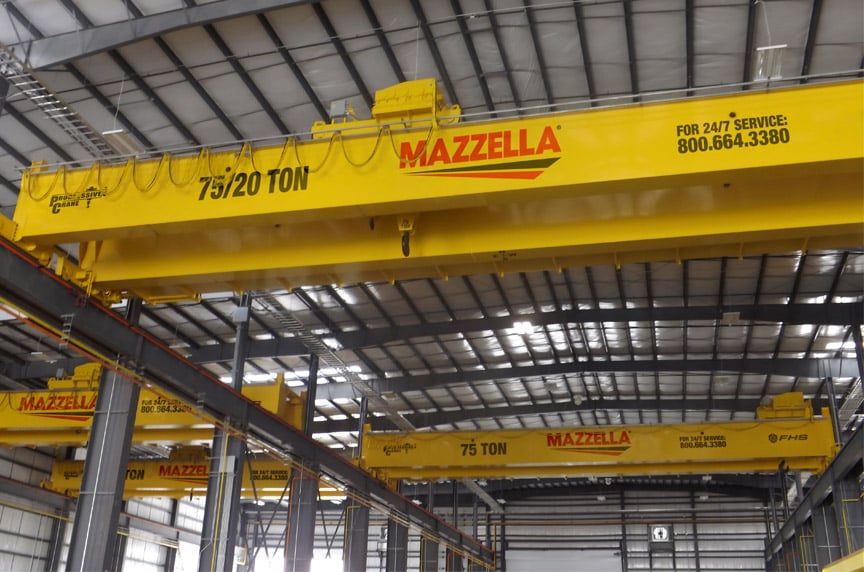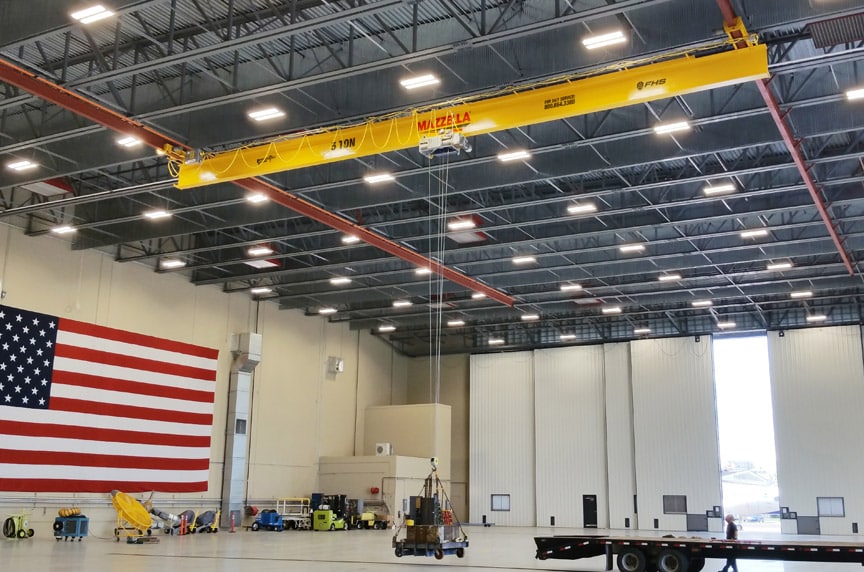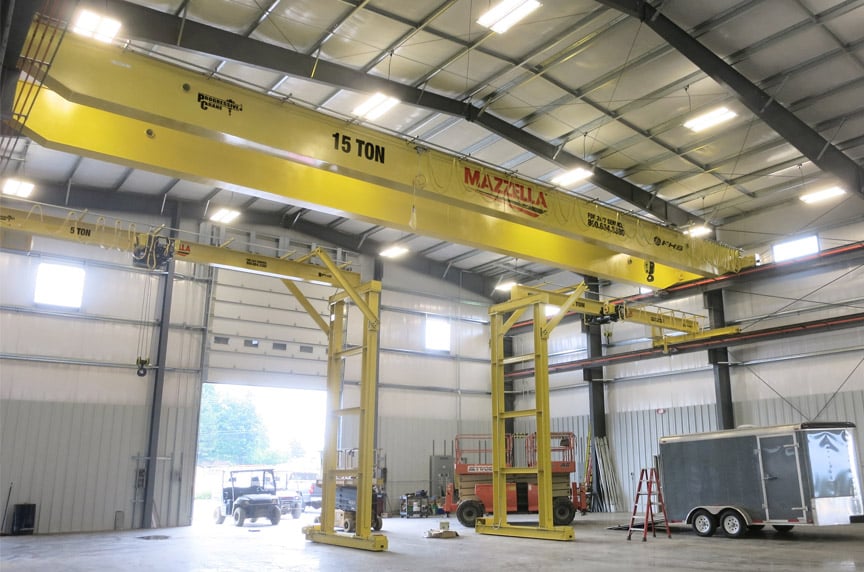If you’ve done your research and determined that an overhead crane system could improve your facility’s production or material handling processes, then you’re probably beginning to realize that there are all different types of overhead cranes. Your head may be swimming trying to sort through all of the information that is available on overhead cranes, and you may be asking yourself, “What type of overhead crane do I need for my business?”
Overhead cranes can vary so much in terms of specifications and configurations. No two crane builds are exactly alike! A crane that worked in a similar building structure, or similar lifting application, may not be the best crane for your facility or your application. So, selecting the right type of crane for your business is critical to maximizing efficiency, streamlining workflow, and getting the best bang for your buck.

Our goal for this article is to use our 50+ years of experience to walk you through the different types of overhead cranes including:
- Bridge Cranes
- Gantry Cranes
- Monorail Cranes
- Jib Cranes
- Workstation Cranes
We’ll also discuss the differences between common terms such as “top running,” “under running,” “single girder,” and “double girder” and what they may mean in selecting the right crane for your facility and your lifting needs.
Our hope is that by the end of this article, you’ll have a deeper understanding of how each type of crane works, how they’re used, and the advantages and disadvantages of each type of overhead crane.
If you aren’t familiar with overhead crane terminology, be sure to start with our article “What is an Overhead Crane?”
What is an Overhead Bridge Crane?

You can probably picture a bridge crane in your head—it consists of two overhead runways built into the building’s support structure, connected by a single or double beam configuration, called a “bridge.” The bridge is supported on either end by an end truck, which rides on wheels along a runway or beam—allowing it to move up and down the bay.
Single Girder vs. Double Girder Bridge Cranes
An overhead bridge crane can be configured in a single girder or double girder design. In simple terms, a bridge girder, or beam, is the support structure that allows the trolley and hoist to move from side-to-side along the bridge. The trolley is used to precisely position the hoist prior to raising or lowering a load.
To a degree, both single and double girder cranes are equal in strength and durability. The main difference between the two comes down to hook height, or how high above the ground your hoist can lift. A double girder crane can provide more hook height because the hoist is placed on top of the girders, instead of below them.
There are some instances where a double girder or single girder configuration may be the better option. We’ll discuss some of these instances below:
Single Girder – The bridge consists of one girder beam supported on each side by an end truck. The trolley and hoist are most commonly underhung—meaning they run on the bottom flange of the bridge. They also tend to be less expensive due to:

- Only one girder is required to move the trolley
- Reduction in freight expenses
- Faster installation
- Simpler hoist and trolley design
However, in the instance that a crane needs to handle more than 15 tons, or the span is more than 65 feet, a double girder configuration may be the better option.
Double Girder – There are two girder beams that make up the bridge, and they are supported by an end truck on each side. The trolley and hoist run on a rail installed on top of the bridge girders. Double girder cranes are recommended for heavier-duty applications where the crane has to handle more than 15 tons, or the span is more than 65 feet.

Double girder cranes are the best option when the crane needs to be customized with things like walkways, cabs, magnet cable reels, or other specialized equipment. And on a top running design, they can provide more lifting height since the hoist isn’t hanging underneath the beam.
Top Running vs. Under Running Cranes
When it comes to defining clear differences between bridge cranes, you will want to consider if you require a top running or under running crane.
On a top running crane, the bridge runs on rails along the top of the runway beams.
On an under running, or underhung crane, the bridges are supported by the bottom of the runway beams and the wheels run along the bottom of the lower beam flange.
Top running cranes – These cranes have no limiting capacity—meaning they can be built to go from small capacities to very large capacities. They include a rail installed on top of each runway, and the bridge wheels move on the rail instead of the bottom flange of the runway beam. These cranes are supported by the building structure or runway support columns, or sister columns, and are ideal for moving extremely heavy loads.

Top running cranes can be designed in a single-girder or double-girder configuration:
- Single girder top running benefits:
- Typical load capacity: .25 – 20 tons
- Typical span: under 65 feet
- Typical service: light
- Low deadweight
- More overhead space
- High speed
- Lower production cost / lower overall price
- Double girder top running benefits:
- Typical load capacity: 20-400 tons
- Typical span – over 65 feet
- Typical service – Heavy
- Ideal when extremely high hook height is necessary
- Better hook height
- Most overhead space
- More lift
- High speed
Under running cranes – often called “underhung,” because the crane wheels are supported by the bottom flange of the crane runway beams acting as the crane rail. These types of cranes can allow you to maximize your facility’s floor space for production and storage of material because they are supported from the ceiling trusses or the roof structure. Or, they can be designed to utilize an existing support structure (if adequate), or run on a newly-engineered support structure.

- Typically designed for lighter service / lower capacity applications
- It can become impractical and expensive to engineer an under running crane to make it a high-capacity piece of equipment
- Offers excellent side approaches and maximize utilization of the building’s width and height when supported by roof or ceiling structures
- Hook height is less than top running because bridge and hoist hang underneath runways
Patented Track vs. Structural I-Beams
When it comes to under running cranes, there are two types of beams that are used for the trolley to run on—either a structural I-Beam or an engineered type of beam that is referred to as “patented track.” Patented track is an option versus using a structural I-beam because it is specifically designed for crane operation and is stronger, more durable, and more consistent. An I-beam is rolled from softer, mild steel and has a beveled bottom flange that prevents the trolley wheels from making a constant balanced contact with the beam. This can cause unbalances, uneven wear, and shorten the life of the track section.

On a patented track beam, the lower rail section of the beam where the wheels make contact, is made from specially rolled high-carbon steel for added strength and rigidity. The rail also has a raised tread design that wears evenly and will not peen, or bend, like a standard I-beam will. This allows for added strength and dependability because the rated capacity of the track is not affected by wear.
Process Cranes vs. Modular Cranes
Bridge cranes fall into two categories based on their service, capacity, and environment. Common terms for the two different types of cranes are “Process” cranes and “Modular” cranes. We’ll explain what each of these means in greater detail below:
Process cranes – A process crane is built for a specific need and these types of cranes are heavy-duty (mainly Class D & E cranes) and in constant, or near-constant, operation. They’re typically a top-running, double girder design and have a lot of engineering built-in to perform high capacity lifts, or to perform a very specific task over and over again. Process cranes can be found in places like automotive assembly plants, steel mills, container yards, lumber mills and can perform anywhere from 10-20 lifts per hour at around 50-75% of their rated capacity.
Modular cranes – Often referred to as “kit cranes,” modular cranes are typically found in smaller manufacturing facilities, smaller-sized mills, or machine shops, and have a design consisting of a more base-level hoist, trolley, and bridge. They’re economical and affordable solutions to moving material through a facility and don’t normally come with a lot of extra bells and whistles. Kit cranes are typically Class C and are being used at around 40% capacity, but can be bumped up to Class D with extra engineering built-in if the lifting application requires it.

What is a Gantry Crane?

A gantry crane is similar to a bridge crane, but instead of moving on suspended runways, the crane uses legs to support the bridge, trolley, and hoist. These legs travel on rails that are embedded in, or on top of the floor or ground structure.
A gantry crane is ideal when you require a lightweight and quick knockdown crane for applications that require portability and corrosion resistance. They are also considered when there is a reason not to incorporate an overhead runway system and are most traditionally used in outdoor applications where full beams and columns can’t be installed, or they can be used below an existing bridge crane system. Gantry cranes are commonly found in shipyards, railyards, special construction sites like where a bridge is being built, or in places like steel mills where overhead room may be an issue.
Gantry cranes come in a wide range of designs, including:
- Adjustable Gantries – used for warehousing applications requiring the movement of materials through aisles, doorways, around obstacles, and over or under obstructions. Welding and fabrication shops can use gantry cranes for lifting parts and equipment into position.
- Portable Gantries – used for plant maintenance applications requiring replacement and relocation of equipment and machinery. Service truck applications requiring quick knockdown for fast, easy movement to and from a work site.
- Track-Mounted Gantries – used for applications requiring lifting and moving heavy loads over a fixed route, either manually or motorized.
Moving and lifting heavy materials doesn’t have to involve installing expensive equipment or permanently changing your facility. Gantry cranes do the job efficiently and economically and are ideal lifting solutions because:
- No permanent installation is required—making gantry cranes ideal if you rent or lease your facility
- Quick and easy assembly and tear-down
- Portable design allows for use in more than one facility or work area
What is a Monorail Crane?

Most commonly found in a production or assembly line, this type of crane uses a trolley to carry the hoist along a single path. Monorail cranes do not utilize a bridge or girder design—instead, the trolley is designed to connect to an I-beam, often already built into the ceiling structure, and runs along the flat surface (flange) on the bottom of the beam. They can also utilize a configured support structure as well.
Material can be run back and forth in a straight line, or the rails can be designed with curves, branches, switches, and with changes in elevation. Monorail cranes follow a singular path and are designed for lifts that do not require the side-to-side trolley movement provided by the bridge in an overhead or gantry style crane.
Monorail cranes are perfect for lifting applications where a full-blown crane design is not required. They’re a cost-effective and versatile solution for many assembly line and production applications.
What is a Jib Crane?

Jib cranes come in a number of different styles and types but do not utilize a runway or track system. They can be stand-alone or column / wall-mounted and offer a wide variety of capacities, heights, and spans.
Jib cranes are space-saving, economical, and are ideal for jobs like maneuvering or moving items for assembly within a smaller radius. They can typically offer 180-360° of rotation, and even small ones can hoist several tons of material.
The best way to determine what type of jib crane is best for your application is to consider the following:
- What type of operation or usage will this equipment see?
- What height clearances or spans are required in this work area?
- Is there available support structure available for mounting, or will this be a standalone unit—(floor, wall, and ceiling)?
- What other special options or considerations are required?
- What is the available budget for the system and installation?
What is a Workstation Crane?

Workstation cranes are designed to allow the operators an ergonomic means of moving or lifting loads with limited effort in a smaller size work area. Workstation cranes are typically lighter-duty systems—lifting materials from 150 lbs. up to 2 tons in capacity. They’re designed for repetitive lifting of loads, positioning of loads, increasing worker productivity and ease of work flow.
They can be built and installed easily using a modular design for greater flexibility and do not require an existing support structure for installation.
Which Type of Overhead Crane is Best for Your Business?

Hopefully, you have a better understanding of the best type of overhead crane for your business’ specific lifting requirements. You may realize now that you don’t need a full overhead crane installation, and maybe a workstation crane or monorail crane is the ideal setup for your specific material handling needs. Or, maybe you realize that there will be some additional fabrication or engineering required to install a crane into the existing structure of your building.
Most importantly, take the time to consider the following when considering the different types of overhead cranes:
- Number of cranes required
- Crane capacity
- Hoist capacity
- Number of lifts per hour
- Percent of lifts near or at capacity
- Span
- Hook Height
- Existing runways / support structure in place
- Operating conditions
- Other special considerations
At Mazzella, we design and build world-class overhead crane systems. We have over 50 years of experience in the overhead crane industry and can build custom solutions ranging from light-duty economical cranes to large-capacity, high-duty cycle cranes.
If you’re interested in exploring a safer and more efficient material handling solution for your facility, contact a Crane Specialist today. We’ll work hand-in-hand with your team make sure you get the right type of crane for your business to maximize efficiency, streamline workflow, and get the best bang for your buck.

Copyright 2017. Mazzella Companies.
